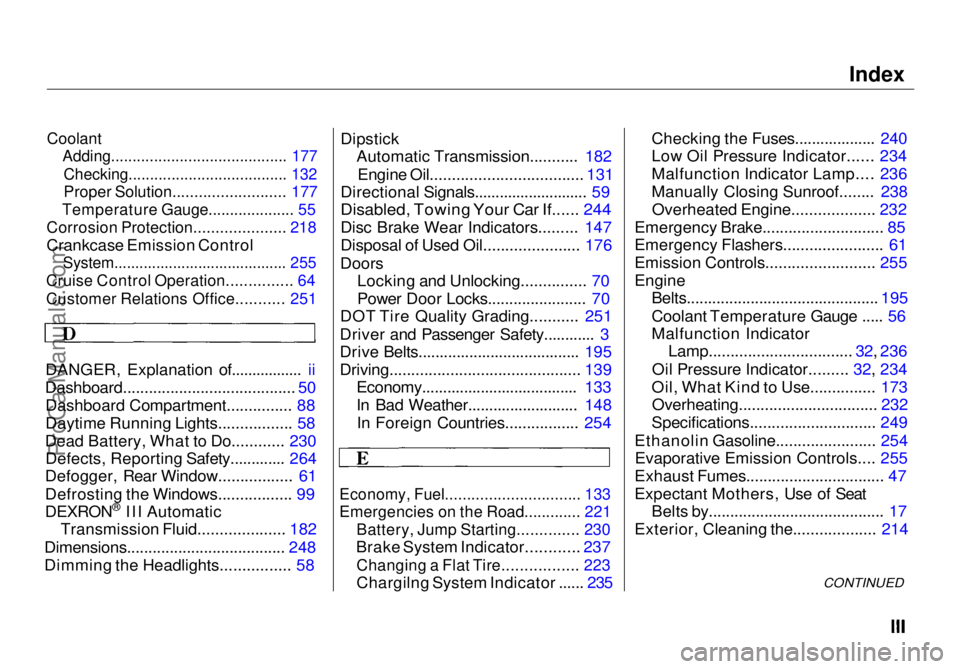Page 95 of 272
Heating and Cooling
Mode Buttons
Use the MODE buttons to select the
vents the air flows from. Some air
will flow from the dashboard corner
vents in all modes. Air flows from the center
and corner vents in the dashboard. Air flow is divided between
the vents in the dashboard and the
floor vents. Air flows from the floor
vents.
Air flow is divided between
the floor vents and the defroster
vents at the base of the windshield. Air flows from the defroster
vents at the base of the windshield.
Comfort and Convenience FeaturesProCarManuals.comMain Menu Table of Contents s t
Page 96 of 272
Heating and Cooling
Vent Controls
You can adjust the direction of the air coming from the dashboard vents
by moving the tab in the center of
each vent up-and-down and side-to-
side.
CORNER VENT
The vents in the corners of the dashboard can be opened and closed
with the dials next to them. How to Use the System
This section covers how to set up the system controls for ventilation,
heating, cooling, dehumidifying, and defrosting.
The engine must be running for the heater and air conditioning to
generate hot and cold air. The heateruses engine coolant to warm the air.
If the engine is cold, it will be several
minutes before you feel warm air
coming from the system.
The air conditioning does not rely on engine temperature.
Comfort and Convenience Features
CENTER VENTProCarManuals.comMain Menu Table of Contents s t
Page 130 of 272
Service Station Procedures
Opening the Hood
HOOD RELEASE HANDLE
1. Shift to Park or Neutral and set the parking brake. Pull the hood
release handle located under the
lower left corner of the dashboard.
The hood will pop up slightly. 2. Standing in front of the vehicle,
put your fingers under the frontedge of the hood to the right of
center. Slide your hand to the left
until you feel the hood latch
handle. Push this handle up until it
releases the hood. Lift the hood. 3. Pull the support rod out of its clip
and insert the end into the hole on
the left side of the hood.
To close the hood, lift it up slightly to remove the support rod from the
hole. Put the support rod back intoits holding clip. Lower the hood to
about a foot (30 cm) above the
fender, then let it drop. After closing the hood, make sure it is securely
latched.
Before Driving
LATCH
SUPPORT RODProCarManuals.comMain Menu Table of Contents s t
Page 135 of 272

Accessories and Modifications
Modifications
Do not remove any original
equipment or modify your vehicle in
any way that would alter its design or
operation. This could make your
vehicle unsafe and illegal to drive.
For example, do not make any
modifications that would change the
ride height of your vehicle, or install
wheels and tires with a different overall diameter.
Such modifications can adversely
affect handling, and interfere with
the operation of the vehicle's anti-
lock brakes and other systems. In addition, any modifications that
decrease ground clearance increase
the chance of undercarriage parts striking a curb, speed bump, or other
raised object, which could cause
your airbags to deploy.
Do not modify your steering wheel
or any other part of your
Supplemental Restraint System. Modifications could make the
system ineffective. Additional Safety Precaution
Do not attach or place objects on theairbag covers. Any object attached to
or placed on the covers marked "SRS,"
in the center of the steering wheel and on top of the dashboard, could
interfere with the proper operation of the airbags. Or, if the airbags
inflate, the objects could be
propelled inside the vehicle and hurt
someone.
Before DrivingProCarManuals.comMain Menu Table of Contents s t
Page 136 of 272
Carrying Cargo
Your vehicle has several convenientstorage areas so you can stow cargo
safely.
The glove box, and the pockets in the front doors and seat-backs, aredesigned for small, lightweight items.
The cargo area is intended for larger, heavier items. In addition, the backseat can be folded down to allow you
to carry more cargo or longer items.
However, carrying too much cargo,or improperly storing it, can affect
your vehicle's handling, stability and operation and make it unsafe. Before
carrying any type of cargo, be sure to
read the following pages.
Before Driving
POCKET
FRONT DOOR POCKET
DASHBOARD
COMPARTMENT
GLOVE BOX
CENTER POCKET
SEAT-BACK POCKET
CARGO AREAProCarManuals.comMain Menu Table of Contents s t
Page 236 of 272
Fuses
All the electrical circuits in your vehicle have fuses to protect them
from a short circuit or overload.
These fuses are located in three fuse
boxes.
The interior fuse box is underneaththe dashboard on the driver's side.
To open it, turn the knob as shown. The under-hood fuse box is located
in the engine compartment on the
passenger's side. To open, push the
tab as shown.
CONTINUED
Taking Care of the Unexpected
INTERIOR
KNOB
UNDER-HOOD
TABProCarManuals.comMain Menu Table of Contents s t
Page 243 of 272
Identification Numbers
Your vehicle has several identifying numbers located in various places.
The Vehicle Identification Number (VIN) is the 17-digit number your
Honda dealer uses to register your
vehicle for warranty purposes. It is also necessary for licensing and
insuring your vehicle. The easiest
place to find the VIN is on a plate
fastened to the top of the dashboard.
You can see it by looking through the windshield on the driver's side. Itis also on the Certification label at-
tached to the driver's doorjamb, and is stamped on the engine com-
partment bulkhead. The VIN is also
provided in bar code on the Certification label. VEHICLE IDENTIFICATION NUMBER
CERTIFICATION LABEL
Technical InformationProCarManuals.comMain Menu Table of Contents s t
Page 265 of 272

Index
Coolant
Adding......................................... 177
Checking..................................... 132
Proper Solution.......................... 177
Temperature Gauge.................... 55
Corrosion Protection..................... 218
Crankcase Emission Control
System......................................... 255
Cruise Control Operation............... 64
Customer Relations Office........... 251
DANGER, Explanation of................. ii
Dashboard........................................ 50 Dashboard Compartment............... 88
Daytime Running Lights................. 58
Dead Battery, What to Do............ 230 Defects, Reporting Safety............. 264
Defogger, Rear Window................. 61
Defrosting the Windows................. 99
DEXRON ®
III Automatic
Transmission Fluid.................... 182
Dimensions..................................... 248
Dimming the Headlights................ 58 Dipstick
Automatic Transmission........... 182
Engine Oil................................... 131
Directional Signals........................... 59
Disabled, Towing Your Car If...... 244
Disc Brake Wear Indicators......... 147
Disposal of Used Oil...................... 176
Doors Locking and Unlocking............... 70
Power Door Locks....................... 70
DOT Tire Quality Grading........... 251
Driver and Passenger Safety............ 3
Drive Belts...................................... 195
Driving............................................ 139 Economy..................................... 133
In Bad Weather.......................... 148
In Foreign Countries................. 254
Economy, Fuel............................... 133
Emergencies on the Road............. 221
Battery, Jump Starting.............. 230
Brake System Indicator............ 237
Changing a Flat Tire................. 223
Chargilng System Indicator ...... 235 Checking the Fuses................... 240
Low Oil Pressure Indicator...... 234
Malfunction Indicator Lamp.... 236
Manually Closing Sunroof........ 238
Overheated Engine................... 232
Emergency Brake............................ 85
Emergency Flashers....................... 61
Emission Controls......................... 255
Engine Belts............................................. 195
Coolant Temperature Gauge ..... 56
Malfunction IndicatorLamp................................. 32, 236
Oil Pressure Indicator......... 32, 234
Oil, What Kind to Use............... 173 Overheating................................ 232
Specifications............................. 249
Ethanolin Gasoline....................... 254 Evaporative Emission Controls.... 255
Exhaust Fumes................................ 47
Expectant Mothers, Use of Seat Belts by......................................... 17
Exterior, Cleaning the................... 214
CONTINUEDProCarManuals.comMain Menu s t
Page:
< prev 1-8 9-16 17-24